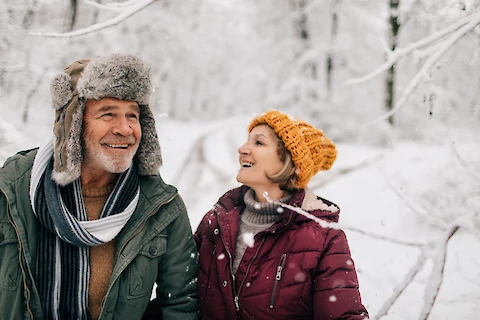
During wintertime in the northern hemisphere, some senior loved ones experience Seasonal Affective Disorder (SAD). SAD is associated with a type of depression that is connected to weather patterns. According to this peer-reviewed study in Science Daily, "Vitamin D deficiency may play a role in depression and possibly other mental disorders." This study addresses how the amount of Vitamin D produced in the body is less when there is less sunlight.
When there is less sunlight and Vitamin D, there is less serotonin produced. Less serotonin means a greater propensity for seasonal depression. Luckily, there are ways to attack seasonal depression, which include using different lighting, increased lighting, and continuing to incorporate sunlight exposure into your senior loved one's routine.
Consider Using a Lightbox for Extra Light
One approach to Seasonal Affective Disorder is using lightbox therapy, which involves senior clients using a rectangular lamp and soaking light in through the lamp. The therapy involves switching the source of light from the sun's rays to a lightbox. Although people may be skeptical that substituting indoor light for outdoor light will help, these light therapy devices are very close to mimicking the type of light emitted from the sun. Here's what to look for in a lightbox:
- 10,000 lux or higher
- Lights that filter out excess UV rays
- Smaller boxes for seniors who travel often
- Upright boxes that can sit on desks or tables
Many seniors enjoy upright lamps that can sit on desks because those are the easiest to use. The easiest way to use a lightbox is to put it on a table and turn it on for about 30 minutes. Then, try an activity or hobby such as watching TV, crafting, or reading the newspaper to pass the time. Professionals recommend avoiding looking at the lamp or light source directly.
Maximize Outdoor Exposure
The other workaround for Seasonal Affective Disorder involves a dedicated effort to find access to natural light. The reason why SAD exists is that the earth's rotation causes people to experience less natural sunlight exposure. The winter sun goes down at a much earlier time, which shortens the daytime. This further prevents seniors from enjoying any late afternoon outdoor activities. The way to retrieve the lost time is to wake up and go out early.
Some senior clients might not be in a position to spend time in the cold, but others will still want to walk and exercise regularly. If it's possible to schedule exercise, then use that as an opportunity for the seniors to get sun exposure. On the other hand, seniors who have trouble being outside in the wintertime can still experience natural lights indoors at places like shopping malls or recreation centers. Caregivers can help seniors cope with SAD by ensuring that the peak daylight hours are spent outside which maximizes the senior’s exposure to natural sunlight. This further means that instead of working out at night, seniors can try to do this in the morning. Or, instead of spending the morning doing leisure activities, it can be moved to later in the day.
About Senior Helpers® Kentucky
Senior Helpers® of Northern Kentucky help seniors take care of their mental health. Our Kentucky offices work in locations like Colonial Heights & Gardens, Edgewood, Florence, and Union. Contact us for more pointers about helping seniors with SAD.